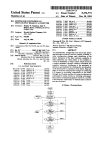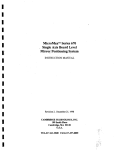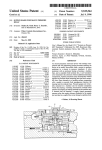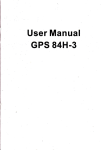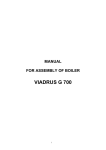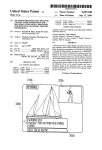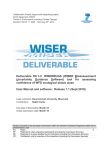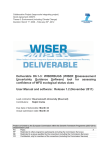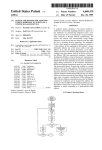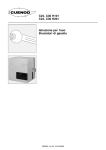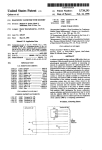Download System for activating and configuring an input/output board in a
Transcript
US005524269A United States Patent [191 [11] Patent Number: Hamilton et al. [45] Date of Patent: [54] SYSTEM FOR ACTIVATING AND CONFIGURING AN INPUT/OUTPUT BOARD 4,755,934 4,760,553 4,825,404 4,849,931 4,904,968 4,904,986 IN A COMPUTER [75] Inventors: Bradley W. Hamilton; John W. Slattery; Kerry J. Monroe, all of Fort Collins, C010. * Jun. 4, 1996 Inoue .................................... .. 364/200 7/1988 4/1989 7/1989 2/1990 2/1990 4,910,655 3/ 1990 4,918,598 4/1990 4,964,038 10/ 1990 4,992,976 2/1991 Yonekura et a1. [73] Assignee: Hewlett-Packard Company, Palo Alto, Calif. [*] Notice: 7/1988 5,524,269 The portion of the term of this patent subsequent to Nov. 22, 2011, has been disclaimed. [21] Appl. No.: 302,142 [22] Filed: Sep. 7, 1994 5,014,193 5/1991 5,031,115 5,034,878 7/1991 Hayashi et al. 7/1991 Haapala et a1. Garner et a1. ....... .. 364/519 364/200 5,038,320 8/1991 364/900 5,111,423 5/1992 Kopec et a1. . 5,161,102 11/1992 Gri?in et a1. . 395/800 5,175,822 12/1992 Dixon et a1. .... .. 395/275 Heath et al. .... .. 5,257,387 10/1993 Richek etal. 5,274,800 5,317,693 5,357,621 Related US. Application Data 364/200 395/500 395/800 12/1993 Babb etal. ..... .. 395/183.08 5/1994 Cuenod et a1. .... .. 395/275 10/1994 Cox ....................................... .. 395/400 OTHER PUBLICATIONS [63] Continuation of Ser. No. 96,196, Jul. 22, 1993, Pat. No. 5,367,640, which is a continuation of Ser. No. 932,919, Aug, Rarnpage® Plus 286 User’s Manual; AST Research, Inc.; Jun., 1988; p. ix. 20, 1992, abandoned, which is a continuation of Ser. No. 693,358, Apr. 30, 1991, abandoned. Primary Examiner-—Gopal C. Ray [51] Int. Cl.6 ............................. .. G06F 13/10; G06F 9/00 [52] US. Cl. ..................... .. 395/829; 395/828; 364/284.2; [58] Field of Search ................................... .. 395/275, 325, software avoids any need for jumpers, switches, or other 395/800, 425, 829, 828, 830, 823; 370/17, 93; 340/825.07, 825.52, 825.06; 364/488, 514; 371/11.l; 361/397, 400 con?guration changes upon installation of the board. Utili zation of the main computer capability to select addresses [57] 364/238.3; 364/280.2; 364/DIG. 1 [56] An automatically con?gurable I/O board and associated and values likely to be available involves an installation or other routine which arrives at a unique parameter through common commands and repetitive execution. Uniqueness of References Cited the parameter or address is accomplished by checking for U.S. PATENT DOCUMENTS Re. 33,705 use elsewhere in the system prior to operation of the board. Steps are taken to avoid any inappropriate changes in 10/1991 Caprio et a1. ......................... .. 364/900 4,268,901 5/1981 4,373,181 2/1983 Chisholm et a1. .................... .. 364/200 4,589,063 4,556,953 ABSTRACT Subrizi et a1. .... ,. . 364/200 con?icting I/O boards by activating and disabling compo nents such as the control register on the board through use 364/900 12/1985 5/1986 Shah Capt-loetetal. al. .... .. . 364/200 . 364/200 4,660,141 4/1987 Ceccon et a1. .. 4,670,855 6/1987 4,675,313 6/1937 Locke, ____________ N 4,730,251 3/1988 Aakre et al. 4,750,136 6/1988 Arpin et a1. .......................... .. 364/514 Caprio et a1. of a state machine, by using non-destructive commands for initial checks, by tristating unnecessary lines, and by re ., 364/900 initializing registers whenever, a con?ict is, encountered. _ _ 364300 Addrtronally no address space is used to activate the board. . 364/200 29 Claims, 3 Drawing Sheets (Dim? ACTIVATE I/O BOARD PRIORITIZED LIST SELECT INITIAL } PARAMETER , _ _ _ _ _ _ _ __ _ _ _ _ _ _ _ _ CONDUCT ASSESS IF UNIOUE _ .., CONFLICT LVL 1 UNIOUENESS ASSESSMENT CONDUCT LVL Z UNIOUENESS ASSESSMENT CONDUCT LVL 3 UNIOUENESS ASSESSMENT STORE PARAMETER CONFLICT US. Patent Jun. 4, 1996 Sheet 1 of 3 5,524,269 F 6E .Ujmzou GENS C1 28 - QmNEo Pm] u=m m < msQz: /U828 BQES/ mN.5zwngz mm.5wzmgz @@ US. Patent Jun. 4, 1996 Sheet 2 of 3 5,524,269 mQ“é.m “N FilI' 1lI| US. Patent Jun. 4, 1996 Sheet 3 of 3 5,524,269 0 0E @ESHEB /\ \F|l ON A, Aa 2 1a a mqwubm 39% 5,524,269 1 2 SYSTEM FOR ACTIVATING AND CONFIGURING AN INPUT/OUTPUT BOARD IN A COMPUTER the board in that slot a speci?c address. While such a solution can overcome the need for installation decisions, it does not meet the criteria of the present invention of accommodating existing designs. CROSS REFERENCE TO RELATED Another solution is that proposed in U.S. Pat. No. 4,964, APPLICATION(s) 038 to Louis. This proposes a system in which all I/O boards connected to the 110 bus utilize speci?c circuitry capable of This is a continuation of application Ser. No. 08/096,196 generating a random address. If there are as many addresses generated as there are boards connected, it can then be ' ?led on Jul. 22, 1993, now U.S. Pat. No. 5,367,640 which was a continuation of application Ser. No. 07/932,919 ?led 10 assumed that each board has a unique address; if not, the on Aug. 20, 1992, now abandoned which in turn was a continuation of application Ser. No. 07/693,358 ?led on Apr. 30, 1991, now abandoned. BACKGROUND OF THE INVENTION 15 Generally, this invention relates to the ?eld of controlling random generation process is repeated. While this solution does speci?cally address the ability to be compatible with standard I/O busses, it has drawbacks overcome by the present invention. Among these are both the requirement that all boards to be of that type (again not allowing accommodation of existing systems) and the inherent di?i input/output boards which are connected to an I/O bus. culties of using randomly generated addresses in con?gu Speci?cally, the invention focuses on techniques to con?g~ rations which usually place some constraints on address ure aspects, such as address space, of input/output boards without needing to physically connect or change jumpers on the card either at physical installation or after a system possibilities. change. Assembling computer systems to suit individual needs or desires by adding peripheral devices is often done. When such devices are connected, frequently they connect to the computer through an 110 card. These 110 boards are installed 25 at initial computer manufacture as well as whenever a user adds new capabilities to the computer by plugging them into know how each system might be con?gured. In addition, it available slots on the input/output bus of the computer. Unfortunately, the process of adding capability involves more than just “plugging in” the I/O board and running the One other solution is that proposed by U.S. Pat. No. 4,675,813 to Locke in which the I/O board includes circuitry which speci?cally recognizes a hardwire-set address and a con?gurable address register. While this solution can work with a standard I/O bus and with other, traditional I/O boards, it has other limitations. It does require the hardwire set address to be unique. This can be unacceptable in the present environment in which a manufacturer simply carmot 30 also is limited in that only one such I/O board can be placed in any system. Again the present invention overcomes such limits. computer. The user or installer must con?gure the I/O board While each of the above limitations have been recog so that the computer can recognize it to communicate with nized, a solution to such problems, among others, has not it. This can be an involved process. When a standard I/O been available prior to the present invention. Certainly the bus——the type of I/O bus traditionally installed in most 35 long felt need existed and as the present invention shows, the computers—is involved, this process can be quite involved. implementing arts and elements had been long available. For a computer to be able to communicate with the I/O board, the computer must not only know what type of board it is, it must be able to selectively locate the I/O board and direct communications only to it. This is referred to as Those skilled in the art appear to have been led to believe that hardware and other such solutions were the only prac 40 addressing the I/O board. As an example of the dif?culties potentially encountered when assembling or changing such computer systems, the address must be assigned so that no other I/O boards have that same address. This problem of address allocation has been known for many years; several different solutions have been proposed, all with limitations overcome by the present invention. Several of these solu tions, are discussed herein. Perhaps the most common solution, and that referred to tical possibility by some of the prior eiforts. In addition, the degree to which the common usage preconditions approaches from device, command, and connection perspec tives has taught those skilled in the art in a direction away from that taken by the present inventors. Each appear to 45 have taught away from the combination of commercial sensitivity and technical expertise necessary to achieve the present invention. All may have combined to cause the simple fact that those skilled in the art failed to see that the problem could be solved in a relatively simple manner. 50 above is to provide physically changeable circuitry on the H. SUMMARY OF THE INVENTION I/O board itself. The address or other characteristic is thus personalized by switches or jumpers which the installer must The present invention discloses a method and apparatus know how to set. The main drawback is that manual which can accomplish automatic I/O board con?guration intervention is required at installation time which may lead 55 even when connected to a standard I/O bus. The technique to con?guration errors. This can also require more detailed involves software routines executed by the computer which customer documentation and, as a practical matter, often ?rst acts to activate the I/O board, then to install the. I/O leads the user to enlist professional help. A second solution in the prior art is to replace the I/O bus. Recently, I/O busses have been developed which can spe ci?cally select one of the slots available through a slot select line or other technique. Naturally this has the undesirable 60 board. This activation is accomplished in a manner which avoids any use of address space during activation and consequence of increasing cost and possibly even making requires a minimum in terms of speci?c I/O board circuitry. Once partially activated, the technique selects an initial slot location an important installation criteria. As an example of such a solution, U.S. Pat. No. 4,755,934 to Inoue discloses a system which selects a board location by a slot select signal generated through the 110 bus and then assigns board properly, and then automatically acts to con?rm such installation as part of the operation of that 1/0 board. In use, the routine initially activates some aspects of a speci?c I/O 65 address or other parameter in a fashion which is likely to result in a unique address. The routine then assesses if this initial address is unique, if not, another address is selected. 5,524,269 3 4 If the address is unique, the routine assigns the address to in use even though such boards utilize the same address. In that 1/0 board. The technique can act to disable electrical connections so as to avoid any inappropriate responses. so providing, the invention greatly expands the number of possibilities for numerous peripheral devices while still After installation, the technique can also act automatically to con?rm proper installation each time the I/O board is accommodating a standard I/O bus structure. Naturally, further objects of the invention are disclosed operated. Thus it will even overcome address or other throughout the speci?cation and claims. con?icts created unwittingly even after the particular board has been installed correctly. An object of the invention is to provide a device which simpli?es installation needs. Naturally it is an object to avoid any need for the installer to have any specialized knowledge or training in order to accomplish installation. Additionally, it is an object to minimize the need for HI. BRIEF DESCRIPTION OF THE DRAWINGS 10 FIG. 1 is a ?ow chart diagram of the installation mode of the present invention with a variety of routines included. FIG. 2 is a schematic representation of the state machine portion of an I/O board according to the present invention. FIG. 3 is a schematic representation of one embodiment involved installation documentation. It is thus an object to achieve assignment of address or other parameters automati 15 of the present invention showing internal elements of the cally through operation of the computer. In assigning such parameters, it is an object to accomplish the task e?iciently in a manner which prioritizes likely assignments and thus achieves the assignment as quickly as possible. An important object of the present invention is to mini‘ computer. DETAILED DESCRIPTION OF THE PREFERRED EMBODIMENTS 20 rnize any hardware required on the I/O board itself in order to achieve the objects herein stated. Accordingly, the present invention has the object of utilizing computer capabilities with minimal added board capabilities in order to accom plish its functions. An object is thus to avoid use of address space to con?gure the board during activation on the I/O board and to ei?ciently store the address, once assigned, on 25 thus to use existing features of most I/O boards to the extent possible. Another object of the present invention is to provide both the method and a device which integrates with existing designs of computers. Accordingly, it is an object to achieve 45 minimize any use of potentially destructive actions in achieving its aims, but it also acts automatically to purge any undesirable effects when such become possible. 50 municating between the I/O board and the computer (14). If it to that 1/0 board. In so doing, it is an object of the the 110 bus (15) is a standard bus, it will not have the invention to use common commands-that is commands 55 the invention to provide only so much operation as neces sary to discover a con?ict and thus not only achieve its aims ef?ciently, but avoid inappropriate results as much as pos sible. Yet another object of the invention is to accommodate 60 user input when necessary or desired. The invention not only allows the user to override the automatic parameter selection process, but it also allows the user to change the con?gu ration of the I/O board itself if desired. 65 Finally, it is also an object of the invention to provide con?gurations which allow a variety of I/O boards to remain the computer (14) system. In most computer systems, this is usually done by connecting the I/O board into a board slot within the computer case. This board slot is actually a connection to the 110 bus of the computer (14). It establishes a number of speci?c connections between the computer (14) and the I/O board. The 1/0 bus (15) serves, together with its numerous electrical connections (20), as a means for com parameter is unique to the I/O board before acting to assign traditionally available and utilized by most I/O boards-in assessing such uniqueness. In addition, it is also an object of include a more detailed interaction than the installation mode, or may be a more abbreviated interaction than that of the installation mode. Thus, once all possible details are understood, each may be combined as desired to achieve the goals of the invention. This would be evident to one skilled in the art and is disclosed to some extent in the claims, although they do not set out all the possible combinations. Naturally, to need the invention, an I/O board, or some type of interactive circuitry—which may or may not be separately attached to the computer-must be connected to change in system con?guration. Not only does the invention As mentioned, an object is to assess if the address or other appropriate con?guration parameters. These interactions can interactions accomplished in the installation mode, may 35 nize such a con?ict. Yet another object of the invention is to provide a tech nique which avoids undesirable eiTects in the event of a by those skilled in the art once its general nature is known. Basically, the technique uses an initial series of interactions between the computer (14) and the I/O board to arrive at the be, but need not be, accomplished in two modes: an instal lation mode and an operation mode. The ?rst mode is installation. This is when a peripheral is introduced to the computer system for the ?rst time or when a user is recon?guring the computer system. The second mode is normal operation of the I/O device, for example a tape drive. This can include either a repetition of the the board in existing components. Generally, an object is the functions desired while allowing use of a standard I/O bus. In addition, it is an object to allow utilization of the invention with existing I/O boards if desired. In so doing, an object is to not only achieve proper con?guration upon installation, but also to strategically check the installation at various times to con?rm that no con?guration changes, or additions of I/O devices, have occurred that might have created a con?ict. Additionally, it is an object that if such a con?ict is created, for the invention to automatically recog As can be seen from the drawings, the present invention is relatively simple in nature and can be easily accomplished inherent capability to select each slot individually. Thus, for the present invention, the I/O board may be randomly connected to any slot of the I/O bus (15), it is not dependent on location. Once physically installed, the methods of the present invention can then be initiated automatically or by the user by activating the installation mode of the invention when desired prior to running that I/O board. Thus the user need only plug the board in and put the cover back on the computer (14). The invention software will appoint the parameter and con?gure or recon?gure the I/O board. In contrast, many devices of the prior art required more action on the user’s part. For example, to recon?gure an I/O board, it often was necessary to power down the computer, remove the cover on the system, adjust the switches and/or change 5,524,269 5 6 jumpers which sometimes required removal of the board, plug the board back into the system, replace the cover, restore power to the system, and reboot the computer. Obviously, this was very time consuming and was prone to signi?cant advantages not only in cost, but also in function ality. While the prior art teaches not only utilizing address space for activation, but also conducting the potentially destructive operation of writing to an address space, the confusion and errors as users often found it di?icult to match present invention signi?cantly departs from this approach. the hardware setups con?gured by the jumpers or the As mentioned, state machine circuitry (10) as shown in ?gure 2 is con?gured to react to a sequence speci?c to that 1/0 board. Referring to FIG. 2, it can be seen that this switches to the parameters set in the con?guration ?le on the hard drive. To understand the various routines of the invention, a review of the technique in the context of the installation circuitry is responsive to computer signals and actually includes one or more programmable array logic unit (PAL) (11) and counter (12). This is relatively inexpensive. Also, by placing such circuitry on the I/O board itself, the inven tion can meet its goal of being compatible with standard 110 mode is representative. Referring to FIG. 1, a flow chart of one possible installation sequence, it can be seen that the present invention greatly simpli?es this process from the busses. The actual sequence which state machine (10) rec user’s perspective by accomplishing the key steps through software routines. As FIG. 1 shows, the installation mode begins with the step of initiating the routine. This can be done automatically, or by user action. When done automati cally, it is of course accomplished after the initiating opera tion of the computer (14) in the traditional manner. Once initiated, the invention acts automatically to selectively ognizes may be set through interruptible wiring (13). State machine (10) has the inherent capability to automatically 20 activate an I/O board and select an initial value for the I/O board (the order of these is not important). The way in which the present invention individually activates an I/O board oifers many advantages. First, it does not require a separate line from the I/O bus (15). Second, it can be accomplished with relatively inexpensive circuit additions to the I/O board. Essentially, the activation opera tion is individualized to a single board by using a speci?c sequence of common operations. The 1/0 board is con?g ured to recognize this unique sequence, and then to activate In addition, state machine (10) is con?gured with a global 25 30 assess the uniqueness of the assigned parameter. 35 board can recognize. This is recognized by use of circuitry sequence differ by only one value in the read sequence. The speci?c orders of the two are only one different. This simpli?es circuitry required as one skilled in the art would readily recognize so that instead of having two separate state machines totally independent of each other, the board may commonly referred to as a state machine (10), as those have one state machine with just two diiferent options at a 40 could be used under the concepts of the invention, the preferred embodiment uses a read sequence referred to as particular state. In addition a board speci?c deactivation command can, of course, be provided if desired. It should be understood that the process of activating an individual I/O board does not involve either a response from the board or the creation or change of any information on the the “?rst read sequence.” The ?rst read sequence activates technique also has the advantage of allowing multiple activate all boards in order to tristate them. For e?’iciency, the global sequence is a sequence which starts with the address read from base address with an oifset of three. Thus, in operation, the second read sequence routine performs two reads from base address with base offset of three. For further e?iciency, the global sequence and the unique activation the I/O board need be initially activated as is necessary to ' the board to enter a setup mode. This unique activation sequence referred to as the “second read sequence.” Thus each board may be con?gured to respond to two speci?c sequences: one to activate a speci?c board, and one to protection against inappropriate responses, only so much of skilled in the art might readily understand once they are exposed to this unique use, even though state machines are traditionally not used for such a routine. While any sequence will move state machine (10) on to the next state. If the state machine requires sequences to occur in a speci?c order, any sequence outside the order will reset the state machine. some aspects of the board in response. As an additional As mentioned a speci?c sequence is used which the I/O reset if the complete sequence is not received. This means that any read sequence not matched in the read sequence described above will reset state machine (10). If the sequence is followed, each successive read in the sequence 45 board. First, avoiding any need for a response allows the state machine to monitor for the proper sequence without the boards to share addresses, DMA channels and IRQ channels. It thus acts to greatly increase 110 board possibilities. In order to allow individual activation, the sequence needs I/O board being activated. Second, the aspect of avoiding any creation or change of information, that is, being sub stantially non-destructive, serves to avoid inappropriate to be unique. It should act as a type of combination to unlock the board that other software or frmctions will have a very, responses within the system as discussed later in the context of the step of assessing if the chosen address is unique. very low probability of performing. In the preferred embodi Either before activating aspects of one I/O board, or ment, a series of sixteen properly chosen I/O reads is used immediately afterward as shown in FIG. 1, the technique because it has been found that such a sequence rarely occurs selects an initial parameter value. Again, as accomplished in in normal operation. Naturally, this number may vary based 55 the preferred embodiment, the base address parameter is upon system con?gurations likely to be encountered. At selected. Rather then merely randomly trying a base address present, it is believed that less than four I/O reads in the ?rst read sequence would not present a su?icient number to properly serve as the combination lock desired. Naturally as shown by the prior art, the invention utilizes a prioritized list. This list is actually generated and stored on the com puter (14) prior to these steps. Thus the memory means (17) the number of reads can be increased as desired. In addition to being a series composed of common commands, the use of a read sequence in general offers the of the computer (14) serves as part of the means for assigning the address (16) or other parameter which is on the computer (14), rather than added to the I/O board. The prioritized list is designed to start with the most likely address to be available initially. It is prioritized based on additional advantage of being substantially non-destructive. This is discussed later in the context of the step of assessing if the chosen address is unique. Also, the use of state machine (10) allows individual activation to occur without utilizing any address space on I/O board (2). This can afford 65 widely disseminated industry speci?cations which specify what addresses some peripheral devices use. Naturally this order may change from time to time as additional informa 5,524,269 7 8 tion becomes available. In addition, user ovenide is pos as if a command which is destructive is used, any unsuc sible. This would best be accomplished without accessing the board itself, So keyboard input is accommodated in the potentially important information. cessful attempts at assigning an address would destroy preferred embodiment. Unlike the ?rst read sequence, the read sequence does not rely on order to the same extent. Instead it is merely a true At present, the list includes only seven possible base read sequence which ascertains the information contained in each address location. Again, for e?lciency, an I/O board addresses. This minimizes the hardware required on the I/O board. Naturally, additional base address possibilities can be included if desired. In order to accommodate operational needs (well understood to those in the art) in an e?icient manner, each of these base addresses is chosen not only for its probability of being otherwise unused, but also so that most have at least sixteen contiguous bytes free. In operation, the computer (14) acts to select the most according to the present invention may be con?gured (but need not be so con?gured) so as to have an identi?cation 10 code in such address location. Thus the read sequence also discovers useful information in the event the address is found to be unique. The con?ict check through this sequence is accomplished by reading each address location used by the particular I/O likely base address to be available as an initial address. This board. It can do this sequentially. It is thus repetitive not in initial address is then assessed to see if it is unique to that 1/0 15 the sense that it does the same thing over and over, but rather board. If it is not unique, the next on the list is tried and so in the sense that it does a different operation to see if the on. board correctly responds to each operation. In the case of the read sequence, not only must an identical identi?cation code be returned at each location, the identi?cation code must be consistent with a list of acceptable codes contained in a table. If the value read back is not in the software table on Once an initial parameter value (such as a base address) is chosen, the technique automatically acts to assess if that value is unique to the I/O board. By doing this through operation of the computer (14), the computer (14) serves as a means for assessing uniqueness in contrast to the prior art. the computer (14), in other words, if the contents received Again, by using the computer’s programmable processing back from the address locations are not what should be capability (21) cost is saved. Certainly the use of a priority list developed with the intent that the ?rst value be unique is an advantage over the prior art which merely uses random expected from any of the known boards that could possibly 25 that a possible con?ict at that address exists. If a con?ict is indicated, the routine returns to select the next most likely address and tries it. Importantly, such a technique is effective because in the event two boards respond at once (i.e. both recognize the same address) an generation of an initial value. In some instances this may be enough, however, in order to accommodate the broad varia tion in system con?gurations, this initial choice needs to be checked. As alluded to in the prior art this can be accom unintelligible signal is produced. This signal will thus be plished through a unique routine, however, the present different from the identi?cation code and will thus indicate that the initial address is not unique. invention accomplishes this through the use of common commands in several unique manners. First, it allows for a multileveled, escalating assessment routine. Second, it accomplishes initial assessment in a fashion which is sub 35 stantially non-destructive and which provides additional information. .Third, it uses a repetitive routine. Refening to FIG. 1, it can be seen how the step of assessing if the initial address is unique is accomplished in 40 a multilevel, escalating manner. As shown in FIG. 1, three levels of assessment are accomplished. While naturally, any number is possible, the important aspect is that at the end, it be well known that the selected address is in fact unique. The ?rst level starts by using common commands which are substantially non-destructive to avoid destroying any infor reside in the system, the routine assumes no board exists or As an additional note, it should be understood that the board identi?cation code not only tells the software which board is being installed, but it also tells it how may bytes to read since some boards use 8 bytes and others use 16 bytes, etc. The identi?cation code can also indicate what hardware version is being installed. This allows updates or revision to the board to be recognized by the software where necessary or desired. Earlier, it was mentioned that the routine used to assess if the chosen address is unique is an escalating routine. By this 45 it is meant that the routine next executes commands which have an even higher probability of discovering a con?ict. mation which could be contained on other 110 boards which The next level of assessment is to write to the board to tell it to return a value other than the identi?cation value. In the command or otherwise. As with the commands chosen to preferred embodiment, a common command is sent to the activate and deactivate the I/O board, this step may use 50 I/O board which resets the same values to return all bits as another such sequence, referred to here as a “read sequence.” zeros. This creates a command-response sequence. Also the In choosing such terms to identify the various read state machine can be expanded to perform this function sequences involved, it should be understood that no order is without any need for a write operation. Again, for e?iciency, might recognize the initial address by executing a write implied. The terms “?rst read sequence,” “second read sequence,” and “read sequence,” are chosen for differentia tion purposes only as the techniques of the invention can be arranged in any order and still fall within the scope of the invention. As mentioned, the commands are substantially non-de by using a single operation to reset all such values, less steps 55 structive. This means that they are of such a character as to be very unlikely to change any information contained on the I/O board or within the computer (14). Certainly a write command acts to replace infonnation contained at the write location. As such it is a destructive operation. While a read sequence can change information, this is far less likely, thus it is a substantially non-destructive operation. In the context of activating the board as discussed earlier, this is signi?cant are involved. As with the read sequence con?ict check, all values are compared by the computer (14) to assure that two boards do not respond at the same time. If a con?ict exists, again, the routine returns to select another address and try it. The prior process is repeated for the third level of con?ict check with an operation which establishes all bits as one’s at the same locations. If it indicates that no con?ict was discovered, a unique address has been chosen. In addition, the computer (14) has identi?ed that a board is residing at that location and what type of board is residing at that 65 address location. All this has occurred without ever com municating with the board in the formal sense and even without ever fully activating the board. 5,524,269 9 10 In regard to the prior steps, it should be understood that any type of operation or command can be chosen, that any number of repetitions can be used, and that any level of checking can be instituted. While at present three levels have been found to be adequate, as the con?gurations of systems encountered changes, so, too, may the types or numbers of routines used change. In addition, the invention also offers As mentioned earlier avoiding inappropriate responses during the attempts to arrive at a unique address is an advantage of the present invention. This is not only accom~ plished by using substantially non-destructive commands and rebooting the system when appropriate, but it is also accomplished by only activating certain aspects of the I/O board. Initially the present invention is con?gured to start out in a default condition having all important connections, the speci?c connections established by the board slot, in the an additional degree of protection against inappropriate responses. In the event that a con?ict is discovered anywhere in the process, not only does the routine act to select another electrically disconnected or tristated condition. The neces sary lines must be untristated so that they can be used. This includes any combination of data lines (which are connected address, it also triggers the need to reboot the system after ?nally storing an appropriate address and other information. This reboot acts to reset the entire computer system (or at least so much as might reasonably be aifected) and thus will to the address space), DMA lines, IRQ lines, and the like. This is easily accomplished through use of a control register act to avoid any inappropriately set values in the systems 15 as those skilled in the art will readily recognize. Other Naturally, if the address initially selected turns out to be techniques are, of course possible. While such registers are unique, no such reboot will be necessary. used to tristate some of the speci?c connections of the board, Once a unique address has been chosen, the setup, or their use is not normally associated with an automatic installation mode can be exited. Again, this can be accom con?guration routine as disclosed here. By tying the control plished by executing a standard command, in this case a register to the state machine, it can only be utilized after a write at the base address with an o?set of seven. Notice that unique address has been assigned. This fact, and the fact that the board has not yet been operated. Rather the unique parameter is saved for later use in the operation mode. The entire routine can then be repeated to change other addresses, other parameters, other boards, and the like. the con?guration of the board has a default tristate condition, further affords the advantage of avoiding any inappropriate responses by preventing electrical activation of the lines 25 As mentioned earlier, there is the possibility of manually means for tristating such lines. Once a unique parameter is found, it may be stored, preferably on existing, nonvolatile memory of the computer (14) system, such as the hard disk (18). While a nonvolatile changing the activation sequence. Referring to FIG. 2, it can be seen that state machine (10) is in part con?gured by interruptable wiring (13). By merely interruptible one or more of the traces comprising wiring (13), the user can 30 physically change the sequence recognized. This, in turn, changes the activation combination recognized. Thus in the saves cost. The unique value can then be used in the second mode, the operational mode. 35 Once the software now knows which board the user wants to con?gure, it is likewise possible to select unique direct storage means can be added to the I/O board as in some prior art devices, the present invention uses existing nonvolatile memory on the computer for e?iciency purposes. This also event a user desires to have two identical boards it can also be accomplished by the present invention. Two traces are shown in FIG. 2; by providing four traces sixteen combi nations are possible. This would allow sixteen possible 1/0 read sequences in a computer system for the same type of board. “before their time.” Thus the I/O board itself can contain the 40 memory access (or DMA) channels and interrupt (or IRQ) channels. In addition, and incidentally highlighting how The operational mode of the present invention can be nearly identical to the installation mode, can include less than the installation mode, or can include more than the installation mode depending on circumstances or desires. While at ?rst glance it may appear unnecessary to re-do each of the steps, this cannot be known with adequate certainty since changes in system con?guration can be frequent and since the invention is designed to be compatible with other, traditional I/O boards. Thus prior to actually initiating operation of the I/O board, the step of con?rming parameter uniqueness can be accomplished. Naturally this can and features may or may not be combined and still fall within the present invention, the preferred embodiment does not use the full three level con?ict check to assign these parameters. Instead, such are merely chosen from a prioritized table should use the information obtained during the installation without a full con?ict check since it is far less likely that a mode for ei‘?ciency. con?ict will exist at this stage. In addition manual selection In the preferred embodiment, most of the steps are iden is possible. Once again, the manual selection does the same thing for DMAs and IRQs as it did for base address. As for 50 tical with only minor exceptions. Irnportantly, the initial address or other parameter selected to be tried should be the the DMA channel parameters it is con?ict checked only in value originally arrived at through the installation mode. the event a particular I/O board type is involved. Recall that This is relatively straightforward. the type of I/O board was determined by the computer (14) As to the level one con?ict check, namely accomplishing as part of the initial address con?ict check. This information can then be used to trigger con?ict checks only for particular 55 the read sequence, it is already known that a board exists and what type of board, so the routine will perform the read board types, further highlighting the ?exibility of the present invention. For the speci?c assignment of a compression sequence for that one board. DMA channel when a compression card is involved, the routine merely checks for a con?ict by using the channel. A small block of data is sent to the I/O board, is passed through one of the chips on the board, put back on the hard drive, and compared to what was sent. If it is identical, uniqueness is assumed. Again, this is a speci?c routine which is presented assigned to the board. While, as mentioned before, this is in volatile memory, the two part procedure used in the pre ferred embodiment overcomes~and even takes advantage of-this limitation. In addition, the invention expands upon how the prior art stored such information by using not only In the operational mode, the unique parameter is also only to highlight the ?exibility offered by the present inven tion. Naturally other such speci?c testing can be accom plished and still fall within the scope and spirit of the present invention. the board register, but by using the Application Speci?c 65 Integrated Circuit (ASIC) (19) on the board. By so doing the invention achieves such storage while potentially reducing costs. 5,524,269 11 12 Finally, after all operation of the board for the present 4. A method of automatically con?guring an input/output session is done, such lines may be tristated. If done at this point, it allows sharing of the same base address, DMA channels, and/or IRQ channels. This can be easily accom plished through the control register as mentioned earlier. As will be readily understood by those skilled in the art, board in a computer and having a plurality of components thereon as described in claim 3 wherein I/O board has data lines and wherein said step of automatically establishing said plurality of speci?c connections in an electrically disconnected state ftuther comprises the step of tristating said data lines. the foregoing methods may be accomplished with only 5. A method of automatically con?guring an input/output minor changes to traditional I/O boards. With reference to board in a computer and having a plurality of components the claims, it should be understood that the various steps can be accomplished by means which may already exist on the 10 thereon as described in claim 3 wherein I/O board has interrupt lines and wherein said step of automatically estab computer (14) on traditional boards. This is in keeping with the goal of requiring the minimum amount of change to the hardware of the I/O board as possible. The foregoing discussion and the claims which follow describe the preferred embodiments of the present invention. Particularly with respect to the claims, it should be under stood that changes may be made without departing from the essence of the invention. In this regard such changes will naturally fall within the scope of the present invention. It is simply not practical to describe and claim all possible permutations and combinations of the new routines pre lishing said plurality of speci?c connections in an electri cally disconnected state comprises the step of tristating said interrupt lines. 6. A method of automatically con?guring an input/output 15 lines and wherein said step of automatically establishing said plurality of speci?c connections in an electrically disconnected state comprises the step of tristating said DMA 20 lines. 25 7. A method of automatically con?guring an input/output (I/O) board in a computer and having a plurality of compo nents thereon, including a ?rst component, comprising the steps of: a. connecting an input/output board and a computer; sented here or to describe and claim all possible revisions to the present invention which may be accomplished. To the extent such revisions utilize the essence of the present invention, each would naturally fall within the breadth of protection encompassed by this patent. This is particularly b. initiating operation of said computer; true for the present invention since its basic concepts and understandings are fundamental in nature and can be broadly applied not only to a variety of devices, but also in a variety of manners. We claim: 1. A method of automatically con?guring an input/output (I/O) board in a computer and having a plurality of compo nents thereon, including a ?rst component, comprising the steps of: c. selecting an initial address for said I/O board; 30 d. individually activating said ?rst component on said 110 board by utilizing a non-destructive communication from said computer to said I/O board; e. assessing if said initial address is unique to said 110 board by checking if said initial address is in use elsewhere; 35 a. connecting an input/output board and a computer; b. initiating operation of said computer; c. selecting an initial address for said I/O board; d. individually activating said ?rst component on said I/O board such that other components are electrically dis board in a computer and having a plurality of components thereon as described in claim 3 wherein I/O board has DMA f. assigning said address to said 110 board upon deciding that said address is unique to said I/O board; and g. storing said unique address. 8. A method of automatically con?guring an input/output board in a computer and having a plurality of components 40 connected from said computer and without utilizing thereon as described in claim 7 wherein said 110 board has address space and wherein said non-destructive communi cation uses none of said address space. address space on said I/O board; 9. A method of automatically con?guring an input/output e. assessing if said initial address is unique to said 110 board in a computer and having a plurality of components board by checking if said initial address is in use 45 thereon as described in claim 8 wherein said I/O board has elsewhere; address space and wherein said non-destructive communi f. assigning said address to said I/O board upon deciding cation does not write to said address space. that said address is unique to said I/O board; and g. storing said unique address. 2. A method of automatically con?guring an input/output 50 board in a computer and having a plurality of components thereon as described in claim 1 wherein said step of con vidually activating comprises the step of issuing a sequence of common commands from said computer. necting said I/O board and said computer comprises the step of establishing a plurality of speci?c connections and further comprising the step of automatically establishing said plu rality of speci?c connections in an electrically disconnected state after accomplishing said step of connecting said I/O board and said computer. 3. A method of automatically con?guring an input/output board in a computer and having a plurality of components 55 11. A method of automatically con?guring an input/output board in a computer and having a plurality of components thereon as described in claim 10 wherein said step of issuing a sequence of common commands comprises the step of issuing a ?rst I/O read sequence from said computer. 60 board in a computer and having a plurality of components thereon as described in claim 11 wherein said step of issuing a ?rst 110 read sequence comprises the step of conducting a 12. A method of automatically con?guring an input/output thereon as described in claim 2 wherein said 110 board has a state machine and a control register capable of con?guring series of at least four reads. said speci?c connections and wherein said step of automati cally establishing said plurality of speci?c connections in an electrically disconnected state comprises the step of con?g uring said state machine to allow said control register to accept a condition so as to tristate said speci?c connections. 10. A method of automatically con?guring an input/output board in a computer and having a plurality of components thereon as described in claim 7 wherein said step of indi 65 13. A method of automatically con?guring an input/output board in a computer and having a plurality of components thereon as described in claim 11 wherein said step of issuing a ?rst 110 read sequence comprises the step of conducting a series of sixteen reads. 5,524,269 13 14 14. A method of automatically con?guring an input/output h. operating said computer. 21. A method of automatically con?guring an input/output board in a computer and having a plurality of components thereon as described in claim 11 wherein said step of board in a computer and having a plurality of components thereon as described in claim 20 wherein said step of con?rming that said address is unique to said I/O board comprises the step of selecting an initial con?rming address and wherein said initial con?rming address is the address that has been stored. individually activating further comprises the step of utilizing a state machine on said I/O board and wherein said state machine has been con?gured to react to said sequence. 15. A method of automatically con?guring an input/output board in a computer and having a plurality of components thereon as described in claim 14 wherein said step of con?guring a state machine on said I/O board comprises the 22. A method of automatically con?guring an input/output board in a computer and having a plurality of components thereon as described in claim 21 wherein said I/O board has step of establishing interruptible wiring to said state DMA and interrupt channels, and further comprising the step of assigning unique DMA and interrupt channels to said machine. 16. A method of automatically con?guring an input/output board in a computer and having a plurality of components thereon as described in claim 14 and further comprising the I/O board. 15 step of deactivating said I/O board after accomplishing said step of assessing if said initial address is unique to said 110 23. An apparatus for con?guring an input/output (I/O) board in a computer and having a plurality of components thereon comprising: a. a computer having a means for assigning an address to board. said I/O board and other portions; b. an input/output board having components responsive to signals from said computer; 17. A method of automatically con?guring an input/output board in a computer and having a plurality of components thereon as described in claim 16 wherein said step of deactivating said l/O board comprises the step of individu ally deactivating said I/O board. 18. A method of automatically con?guring an input/output board in a computer and having a plurality of components thereon as described in claim 16 wherein said step of c. a means for communicating between said 110 board and said other portions of said computer wherein said means for communicating between said I/O board and 25 deactivating said I/O board comprises the step of globally deactivating said I/O board. 19. A method of automatically con?guring an input/output board in a computer and having a plurality of components [/0 board through operation of said computer to check if said address is in use elsewhere; and e. a means for avoiding inappropriate responses to said commands. 24. An apparatus for con?guring an input/output board in thereon as described in claim 18 wherein said step of globally deactivating said I/O board comprises the step of issuing a second 110 read sequence from said computer and wherein said ?rst 110 read sequence and said second I/O read sequence have speci?c orders and wherein said speci?c 35 orders are one different. communicating said computer and said I/O board comprises (I/O) board in a computer and having a plurality of compo nents thereon, including a ?rst component comprising the steps of: a plurality of speci?c connections and wherein said l/O board comprises a means for tristating some of said speci?c connections. 26. An apparatus for con?guring an input/output board in a. connecting an input/output board and a computer; b. individually activating said ?rst component on said I/O board by issuing a ?rst I/O read sequence from said computer; a computer as described in claim 25 wherein said means for 45 ing the steps of: i) organizing a priority list of number of addresses based upon the probability of each address being available; ii) choosing an address likely to be available; d. assessing if said initial address is unique to said I/O board comprising the steps of: i) issuing a read sequence from said computer; ii) establishing a ?rst value on a register; iii) reading said register; iv) establishing a second value on said register; v) re-reading said register; e. assigning said address to said I/O board upon assessing that said address is unique to said 110 board; f. storing said unique address; g. con?rming that said address is unique; and a computer as described in claim 23 wherein said means for avoiding inappropriate responses to said commands com prises said I/O board. 25. An apparatus for con?guring an input/output board in a computer as described in claim 23 wherein said means for 20. A method of automatically con?guring an input/output 0. selecting an initial address for said I/O board compris said computer transmits commands; d. a means for assessing if said address is unique to said communicating comprises data lines and wherein said spe ci?c connections which are tristated comprises said data lines. 27. An apparatus for con?guring an input/output board in a computer as described in claim 26 wherein said means for 50 communicating comprises DMA lines and wherein said speci?c connections which are tristated further comprises said DMA lines. 28. An apparatus for con?guring an input/output board in a computer as described in claim 27 wherein said means for communicating comprises interrupt lines and wherein said 55 speci?c connections which are tristated further comprises said interrupt lines. 29. An apparatus for con?guring an input/output board in a computer as described in claim 26 wherein said means for communicating comprises interrupt lines and wherein said speci?c connections which are tristated are said interrupt lines.












